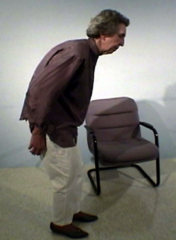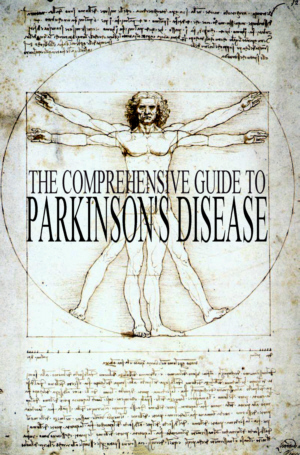|
�
�
�
� � |
Parkinson's Disease News covers
all significant new research, reports, books, and resources concerning
Parkinson's Disease.
Articles are chosen on the basis
of their medical significance or potential interest. Our overwhelming priority
is the facts, regardless of whether they contradict prevailing views or vested
interests. Analysis and further information are provided
either to explain the background or implications, or to
balance misleading claims. If you notice errors or inadequacies, or dispute what is
written, or want to propose articles, please
e-mail
[email protected].
 ��� � ��� �
 ����� �����
 �� �� �� ��
 ���� ����
 ��� � ��� �
 ���� ����
 ���� ����
 ���� ����

�
4th April 2017 - New research
POSTURAL DEFORMITIES IN PARKINSON'S DISEASE
|
�CLICK HERE
FOR A
PRINTABLE OR WHITE BACKGROUND VERSION OF THIS ARTICLE |
Striatal (hand and foot) and postural deformities are known to commonly
occur in people with atypical Parkinsonism, but also occur in people with
Parkinson's Disease. These deformities are frequently misdiagnosed as joint
or orthopaedic problems that can often lead to unnecessary investigations.
For more information go to :
Postural deformities
 Various
striatal (hand and foot) and postural deformities (antecollis, camptocormia,
scoliosis and Pisa syndrome) and their relation with the duration of
Parkinson's Disease, severity and L-dopa intake were analyzed. Of those
people with Parkinson's Disease, nearly half of them (48.5%) had either
striatal or postural deformities. Striatal foot deformities were the most
common deformity observed (25%). Camptocormia was the second most common
deformity (20%). Striatal and postural deformities occur more in advanced
Parkinson's Disease as suggested by higher UPDRS scores.
Striatal deformities almost always (94%) occurred on the same side of
the body as the onset of Parkinson's Disease symptoms. Pisa and scoliosis
occurred more (66%) on the opposite side to the onset of Parkinson's Disease
symptoms. Various
striatal (hand and foot) and postural deformities (antecollis, camptocormia,
scoliosis and Pisa syndrome) and their relation with the duration of
Parkinson's Disease, severity and L-dopa intake were analyzed. Of those
people with Parkinson's Disease, nearly half of them (48.5%) had either
striatal or postural deformities. Striatal foot deformities were the most
common deformity observed (25%). Camptocormia was the second most common
deformity (20%). Striatal and postural deformities occur more in advanced
Parkinson's Disease as suggested by higher UPDRS scores.
Striatal deformities almost always (94%) occurred on the same side of
the body as the onset of Parkinson's Disease symptoms. Pisa and scoliosis
occurred more (66%) on the opposite side to the onset of Parkinson's Disease
symptoms.
The results showed that striatal and postural deformities were common and
present in about half of the people with Parkinson's Disease. These
deformities we more common in people in the advanced stages of Parkinson's
Disease.
Reference : Indian Journal of Medical Research
[2016] 144 (5) : 682-688 (S.Pandey, H.Kumar)
Complete abstract�� For more news go to
Parkinson's Disease News
 E-MAIL NOTIFICATION : If you would like to be
notified by e-mail when any new articles
are added to Parkinson's Disease News,� please merely
e-mail
[email protected] with the message
"subscribe".� No form of identity is required.� E-mail addresses are
not used for any other purpose. E-MAIL NOTIFICATION : If you would like to be
notified by e-mail when any new articles
are added to Parkinson's Disease News,� please merely
e-mail
[email protected] with the message
"subscribe".� No form of identity is required.� E-mail addresses are
not used for any other purpose.
|
|
|
|
�
 |
THE
COMPREHENSIVE GUIDE TO PARKINSON'S DISEASE
The Comprehensive Guide to Parkinson's
Disease, which is fully referenced, and over 800 pages long, is
the most comprehensive book concerning Parkinson's Disease. It includes the history of Parkinson 's Disease, famous
people with Parkinson's Disease, the complete biochemisty of
Parkinson's Disease,
its cytology and cytological effects,
anatomy and anatomical effects, physiology and physiological
effects, symptoms of every system in the body, the diagnosis methods
(observational, technological, chemical), biochemical causes, all the toxic causes, all the genetic causes, all the
pharmacological causes, all the medical disorders that cause Parkinson's Disease
symptoms, its treatments (biochemical, pharmacological,
surgical, natural, exercise methods, technological methods),
including all those treatments that exist and all those treatments
presently being developed, Parkinson's Disease organisations,
Parkinson's Disease web sites, and books on Parkinson's Disease
nursing.
CLICK HERE FOR MORE DETAILS |
�
|

|
� �
�
�
�
�
�
�
�
�
�
�
�
�
� |
.gif)
.gif)
 ��� �
��� �
 �����
�����
 �� ��
�� ��
 ����
����
 ��� �
��� �
 ����
����
 ����
����
 ����
����




